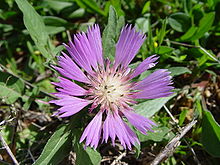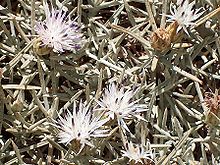Centaurea
| Centaurea | |
|---|---|

| |
| Centaurea pullata | |
| Scientific classification | |
| Kingdom: | Plantae |
| Clade: | Tracheophytes |
| Clade: | Angiosperms |
| Clade: | Eudicots |
| Clade: | Asterids |
| Order: | Asterales |
| Family: | Asteraceae |
| Subfamily: | Carduoideae |
| Tribe: | Cardueae |
| Subtribe: | Centaureinae |
| Genus: | Centaurea L. |
| Type species | |
| Centaurea centaurium L.
| |
| Diversity | |
| Over 700 species | |
| Synonyms | |
|
List
| |
Centaurea (/ˌsɛntɔːˈriːə/)[1] is a genus of over 700 species of herbaceous thistle-like flowering plants in the family Asteraceae. Members of the genus are found only north of the equator, mostly in the Eastern Hemisphere; the Middle East and surrounding regions are particularly species-rich.
Common names
Common names for this genus are centaury, centory, starthistles, knapweeds, centaureas and the more ambiguous "bluets"; a vernacular name used for these plants in parts of England is "loggerheads" (
The name is said to be in reference to Chiron, the centaur of Greek mythology who discovered medicinal uses of a plant eventually called "centaury".[3]
Description
Knapweeds are robust
Ecology
Certain knapweeds have a tendency to dominate large stretches of landscape together with a few other plants, typically one or two grasses and as many other large herbaceous plants. The
Due to their habit of dominating ecosystems under good conditions, many Centaurea species can become
Yet other species of Centaurea – mostly ones that occur between Italy and the
Centaurea are copious
Also used in biological control are
Use by humans
Although the genus may be considered by a quite significant number of relatively informed individuals to have an overall negative impact on human interests, particularly agricultural interests, the situation is not straightforward enough to simply declare the genus, or, at least, its most aggressively-spreading species, altogether negative. For instance, due to their moderate to high nectar production, which can occur over a comparatively long duration, many species of Centaurea are popular food sources for
Some plants which are considered invasive or problematic in certain areas can have beneficial qualities that outweigh their negative qualities from a human and/or human agricultural point of view, although this sometimes requires some human management – particularly if adequate biological control has not been established for the more aggressive species. An example is wild parsnip,
The abundant

Arctiin, found in C. imperialis, has shown
Spotted knapweed as well as other species are rich in
#6495ED
Some species are cultivated as
Systematics and taxonomy

As namesake member of the
Research in the late 20th century shows that Centaurea as traditionally defined is
-
Globe knapweed (C. macrocephala
Species
Better-known Centaurea species include:
- Centaurea acaulis
- Centaurea adpressa
- Centaurea aegyptiaca
- Centaurea aeolica
- Centaurea aggregata
- Centaurea akamantis – Akamas centaurea
- Centaurea alba
- Centaurea albonitens Turrill
- Centaurea alpestris
- Centaurea alpina
- Centaurea ambigua
- Centaurea amblyolepis
- Centaurea americana – American basketflower, American starthistle
- Centaurea ammocyanus
- Centaurea antennata Dufour
- Centaurea antiochia Boiss.
- Centaurea aplolepa
- Centaurea aplolepa subsp. carueliana
- Centaurea appendicigera C.Koch
- Centaurea argentea
- Centaurea ascalonica
- Centaurea aspera L. – rough starthistle
- Centaurea atacamensis (Reiche) I.M.Johnst.
- Centaurea atropurpurea
- Centaurea ×aurata
- Centaurea babylonica L.
- Centaurea balsamita
- Centaurea behen L. – ak behmen (Turkish)
- Centaurea bella
- Centaurea benedicta – Cnicus
- Centaurea bieberseinii
- Centaurea borjae
- Centaurea bovina
- Centaurea bracteata
- Centaurea brevifimbriata Hub.-Mor.
- Centaurea bulbosa
- Centaurea busambarensis Guss.
- Centaurea cachinalensis
- Centaurea calcitrapa – purple starthistle, red starthistle, "caltrop"
- Centaurea calcitrapoides
- Centaurea cariensis Boiss.
- Centaurea cariensiformis Hub.-Mor.
- Centaurea caroli-henrici Gabrieljan & Dittrich
- Centaurea centaurium L.
- Centaurea chilensis
- Centaurea cineraria – velvet centaurea, dusty miller
- Centaurea clementei
- Centaurea collina L.
- Centaurea corymbosa
- Centaurea crithmifolia
- Centaurea crocodylium
- Centaurea cyanoides J.Berggr. & Wahlenb.
- Centaurea cyanus – cornflower, bachelor's button, boutonniere flower, hurtsickle, bluebottle, basketflower
- Centaurea damascena
- Centaurea debeauxii Gren. & Godr.
- Centaurea demirizii Wagenitz
- Centaurea depressa – low cornflower
- Centaurea deusta
- Centaurea diffusa – diffuse knapweed, white knapweed, tumble knapweed
- Centaurea diluta – North African knapweed
- Centaurea drabifolia Sm.
- Centaurea drabifolioides Hub.-Mor.
- Centaurea dschungarica
- Centaurea emilae Hüseynova et Qaraxani[13]
- Centaurea eriophora
- Centaurea eryngioides
- Centaurea filiformis
- Centaurea fischeri Willd.
- Centaurea floccosa
- Centaurea foliosa Boiss. & Kotschy
- Centaurea forojuliensis
- Croatian)
- Centaurea gayana
- Centaurea glaberrima Tausch
- Centaurea glastifolia
- Centaurea grinensis
- Centaurea gymnocarpa
- Centaurea haradjianii Wagenitz
- Centaurea hedgei
- Centaurea helenioides Boiss.
- Centaurea hermannii F.Hermann
- Italian)
- Centaurea hyalolepis
- Centaurea hypoleuca
- Centaurea iberica – Iberian starthistle, Iberian knapweed
- Centaurea idaea – katsoula, tsita (Cretan Greek)
- Centaurea imperialis Hausskn. ex Bornm.
- Centaurea jabukensis
- Centaurea jacea – brown knapweed, brownray knapweed
- Centaurea kasakorum
- Centaurea kopetaghensis
- Centaurea kotschyana Heuff.
- Centaurea lanulata
- Centaurea leptophylla
- Centaurea leucophylla
- Centaurea limbata
- Centaurea lydia Boiss.
- Centaurea macrocephala Puschk. ex Willd. – globe knapweed, Armenian basketflower
- Centaurea maculosa– spotted knapweed (might belong in C. stoebe subsp. micranthos)
- Centaurea mannagettae
- Centaurea margaritalba Klok.
- Centaurea marschalliana
- Centaurea melitensis – Maltese starthistle; tocalote, tocolote (California)
- Centaurea minor
- Centaurea moschata– sweet sultan
- Centaurea ×moncktoniiC.E.Britton – meadow knapweed, protean knapweed (= C. ×pratensis Thuill non Salisb.)
- Centaurea monocephala
- Centaurea montana – montane knapweed, perennial cornflower, mountain cornflower, mountain bluet
- Centaurea napifolia L. – fiordaliso romano (Italian)
- Centaurea nervosa Rchb. ex Steud.
- Centaurea nigra – common knapweed, black knapweed, lesser knapweed, hardheads
- Centaurea nigrescens – Tyrol knapweed, short-fringed knapweed, Tyrol thistle
- Centaurea nigrifimbria (C.Koch) Sosn.
- Centaurea nivea (Bornm.) Wagenitz
- Centaurea onopordifolia
- Centaurea orientalis L.
- Centaurea ornata Willd.
- Centaurea ovina
- Centaurea pallescens Delile
- Centaurea paniculata L.
- Centaurea parlatoris
- Centaurea pecho
- Centaurea phrygia – wig knapweed
- Centaurea pindicola
- Centaurea polypodiifolia
- Centaurea ×pratensis Salisb. (C. jacea × C. nigra) – meadow knapweed
- Centaurea procurrens
- Centaurea ×psammogena G.Gayer. (C. diffusa × C. stoebe subsp. micranthos)
- Centaurea pseudocaerulescens
- Centaurea pseudophrygia C.A.Mey.
- Centaurea pulcherrima Willd.
- Centaurea pullata L.
- Centaurea pumilio
- Centaurea ragusina L.
- Centaurea rigida
- Centaurea rothrockii Greenm. – Mexican basketflower, Rothrock's basketflower, Rothrock's knapweed
- Centaurea ruthenica
- Centaurea rutifolia Sm.
- Centaurea sadleriana – Pannonian knapweed
- Centaurea salicifolia Bieb. ex Willd.
- Centaurea scabiosa – greater knapweed
- Centaurea scannensis
- Centaurea scoparia
- Centaurea scopulorum Boiss. & Heldr.
- Centaurea seguenzae
- Centaurea seridis L.
- Centaurea sibirica
- Centaurea simplicicaulis
- Centaurea sinaica
- Centaurea solstitialis – yellow starthistle, golden starthistle, yellow cockspur, St. Barnaby's thistle, Barnaby thistle
- Centaurea speciosa
- Centaurea sphaerocephala L.
- Centaurea stenolepis
- Centaurea stoebe L.
- Centaurea stoebe subsp. micranthos (Gugler) Hayek
- Centaurea straminicephala
- Centaurea sulphurea – Sicilian starthistle
- Centaurea tauromenitana Guss.
- Centaurea tenoreana
- Centaurea tommasinii
- Centaurea transalpina Schleich. ex DC.
- Centaurea tchihatcheffii — yanardöner (Turkish)
- Centaurea trichocephala Bieb. ex Willd. – featherhead knapweed
- Centaurea triniifolia
- Centaurea triumfettii All.
- Centaurea tymphaeaHausskn.[14]
- Centaurea ucriae Lacaita
- Centaurea uniflora Turra
- Centaurea verbascifolia Vahl
- Centaurea verutum L.
- Centaurea virgata
- Centaurea virgata subsp. squarrosa – squarrose knapweed
- Centaurea wiedemanniana Fisch. & Mey.
- Centaurea yozgatensis Wagenitz
Formerly placed here
Plant species placed in Centaurea in former times include:
- Acroptilon repens– Russian knapweed (as C. repens)
- Cheirolophus crassifolius – Maltese rock-centaury (as C. crassifolia, C. spathulata)
- Femeniasia balearica(as C. balearica)
- Volutaria muricata (as C. muricata)
Footnotes
- ^ Sunset Western Garden Book, 1995:606–607
- ^ a b Keil (2006), Keil & Ochsmann (2006).
- OCLC 61461560.
- ^ a b Hierro & Callaway (2003), Vivanco et al. (2004).
- ^ a b Emery & Gross (2005).
- ^ PMID 27341588.
- ^ a b "Which flowers are the best source of nectar?". Conservation Grade. 2014-10-15. Archived from the original on 2019-12-14. Retrieved 2017-10-18.
- ^ Wäckers et al. (2005)
- ^ Pieroni et al. (2002).
- ^ Stavridakis (2006)
- puncture vine, later named Tribulus terrestris.
- ^ Panero & Funk (2002), Keil (2006), Keil & Ochsmann (2006).
- ^ AMEA Botanika İnstitutunun əməkdaşları Azərbaycan florasında yeni növ aşkarlayıblar. science.gov.az
- ^ Centaurea tymphaea Plants of the World Online
References
- Emery, S.M. & Gross, K.L. (2005): Effects of timing of prescribed fire on the demography of an invasive plant, spotted knapweed Centaurea maculosa. (HTML abstract)
- Hierro. J.L. & Callaway, R.M. (2003): Allelopathy and exotic plant invasion.
- Keil, David J. (2006): 21. Plectocephalus. In:
- Keil, David J. & Ochsmann, J. (2006): 24. Centaurea. In:
- Panero, J.L. & Funk, V.A. (2002): Toward a phylogenetic subfamilial classification for the Compositae (Asteraceae).
- Pieroni, A.; Janiak, V.; Dürr, C.M.; Lüdeke, S.; Trachsel E. & Heinrich, M. (2002): In vitro Antioxidant Activity of Non-cultivated Vegetables of Ethnic Albanians in Southern Italy.
- Stavridakis, Kleonikos G. (Κ. Γ. Σταυριδάκης) (2006): Wild edible plants of Crete - Η Άγρια βρώσιμη χλωρίδα της Κρήτης [English and Greek]. Rethymnon Crete. ISBN 960-631-179-1
- Vivanco, J.M.; Bais, H.P.; Stermitz, F.R.; Thelen, G.C. & Callaway, R.M. (2004): Biogeographical variation in community response to root allelochemistry: Novel weapons and exotic invasion.
- Wäckers, Felix; van Rijn, Paul & Bruin, Jan (2005): Plant-Provided Food for Carnivorous Insects - a protective mutualism and its applications. Cambridge University Press, UK.
Further reading
This article includes a list of general references, but it lacks sufficient corresponding inline citations. (January 2009) |
- Mabberley, D.J. 1987. The Plant Book. A portable dictionary of the higher plants. Cambridge University Press, Cambridge. 706 p. ISBN 0-521-34060-8.
- Robbins, W.W., M. K. Bellue, and W. S. Ball. 1970. Weeds of California. State of California, Dept. of Agriculture. 547 p.
External links
 Media related to Centaurea at Wikimedia Commons
Media related to Centaurea at Wikimedia Commons Media related to Centaurea (category) at Wikimedia Commons
Media related to Centaurea (category) at Wikimedia Commons- Centaurea images
- Flora Europaea: Centaurea
- USDA Plant Profile: Centaurea
- Flora of China: Centaurea species list
- Flora of Chile: Centaurea (pdf)







